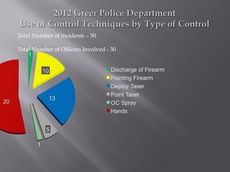
City of Greer Photo
2012 Greer Police Department new hires.

City of Greer Photo
Meth arrests increased 24 percent in 2012. Shown are ingredients for making meth.

City of Greer Photo
Guns, ammo and drugs are displayed after Greer Police confiscated these items after making arrests.

City of Greer illustration
There were 50 documented cases of 30 officers involved in using control techniques.
The 2012 review of the Greer Police Department showed drug arrests increasing 24 percent, as the No.1 nemesis, while the patrol division showed declines in seven of the nine categories.
Reynolds wants more equipment for the meth mitigation team and lab self-sufficiency and to obtain safety, storage and transportation equipment to safely deconstruct methamphetamine labs.
Crime in Greer has reflected a cyclical pattern for the past three years. Up one year, down the next and up in 2012. “I told you last year it seems we are in a pattern I can’t explain,” Reynolds said.
Reynolds summarized his department. “We had two officers deployed overseas, two unavailable with injuries, four retired because of the new state retirement law and two left for other endeavors,” Reynolds said. “This presented a challenge with our resources.”
The police department has 72 positions with Sgt. Randle Ballenger on overseas deployment and due back in the summer.
Reynolds said of the 20 hires there were 13 officers, 2 detention officers, 3 dispatchers, a victim advocate and a crime analyst. Two volunteers from the successful Citizens Police Academy helped support the records division.
A COPS grant, funded by the U.S. Justice Department for $141,005, allowed the hiring of three officers. After the third year of the grant, Reynolds must absorb those hires into the regular police force with additional budgeting approved by council or eliminate the positions.
The Directed Patrol Unit was disbanded last year because of limited personnel. That was reflected in the Patrol Division showing less activity than 2011. The biggest change was in issuing tickets, down 24.3 percent and making 11.1 percent fewer arrests than 2011. “We want to reestablish the DPU by the summer,” Reynolds said.
Patrol Division
|
|
2011 |
2012 |
Percent change |
|
Patrol Response |
28,635 |
27,474 |
-4.05% |
|
Tickets |
6,043 |
4,569 |
-24.39% |
|
Arrests |
2,582 |
2,293 |
-11.19% |
|
Incident Reports |
3,669 |
3,581 |
-2.40% |
|
Collision Reports |
1,087 |
1,057 |
-2.76% |
|
Miles |
378,973 |
332,632 |
-12.23% |
|
Warrants Served |
1,653 |
1,857 |
12.34% |
|
Field Interview |
372 |
534 |
43.55% |
|
Warning Citations |
3,343 |
3,082 |
-7.81% |
Greer police were ahead of the national rates in clearing crimes. Property crimes cleared in Greer were 27 percent to 18 percent national, crimes against person 49-48 percent and 54 percent of financial crimes were cleared in Greer. No national data was reported.
To add to the caseload, Reynolds said detectives were assigned 393 cases compared to 288 in 2011 – 105 more with a transitional staff.
“Prostitution was down (32 arrests vs. 42 in 2011) and that is a good thing,” said Lt. Eric Pressley, head of the Criminal Investigation Division. “We wanted to see if we made an impact there.” On the flip side there was an upswing in drug arrests – 88 in 2012 compared to 67 in 2011.
Several crime series also added to the caseload, according to the report. Two different groups and other individuals were identified as responsible for commercial burglaries, auto-breakings, and larcenies along Wade Hampton Blvd. Several arrests were made ending the crimes series.
“There was an individual arrested with a significant amount of property – $10,000 – and another person was arrested for counterfeiting,” Pressley said.
The PD’s analysis of its offender database and mapping helped solve the above cases and connected the dots on others. Compstat (computer statistics) and density mapping help crime analysts identify crime hot spots along with other trends and patterns.
Reynolds said 2013 presents another challenging year. The department’s goals are to continue to monitor elementary schools, train in active shooter situations and have a bi-weekly review of density maps and selective response to problem areas.
To reduce case loads through offender targeting Reynolds wants to partner with the solicitor’s offices to establish appropriate sentencing for repeat and problematic offenders, partner with probation and parole to build violation cases against repeat offenders and maintain the in-office repeat offender database.